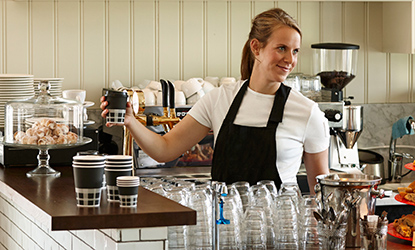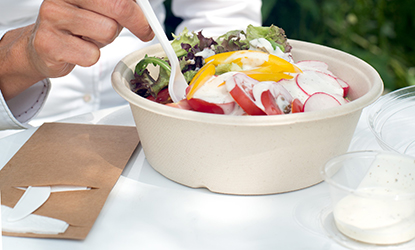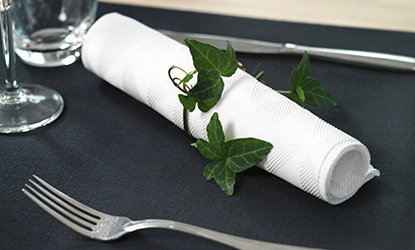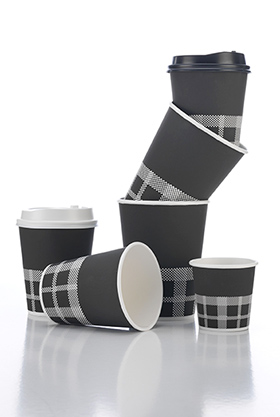Duni's markets
Restaurant chains and take-away continue to grow
The European market for single-use tabletop products is worth around SEK 35 billion (EUR 4 billion. Source: Duni). Duni is the leader within the premium segment and market leader on many of its core markets, which creates conditions for acting as a trendsetter and proactively promoting the trend within the industry towards increased use of single-use products.
The restaurant market is undergoing rapid change driven by trends such as our increasingly mobile lifestyles and the fact that, to an ever increasing extent, we are eating “on the go”. The trend is also partially influenced by the same basic factors as lie behind the general increase in meals consumed outside the home: continued urbanization, an increase in the proportion of single households and in the proportion of the population in gainful employment, and an increase in disposable incomes.

An increasing number of restaurant chains with clear concepts and strong brands are springing up in response to the trend for "good food fast". North America is dominant in terms of restaurant chains as a proportion of the total restaurant offering, with a penetration level of 50%. In Europe, chains account for just under 20% of the total restaurant offering. Eastern Europe and Asia are expected to account for the largest percentage rate of growth, as prosperity increases in countries in those regions.
The percentage of sales in Europe attributable to restaurant chains is continuing to increase, while the percentage attributable to independent restaurants has marginally declined. There is a uniform trend in almost all countries, but with variations in the percentages and rates of increase. Over the course of five years, the chains increased from 52 to 58% in the UK, from 42 to 45% in France, and from 23 to 27% in Germany. In southern Europe, the percentages are lower and the change somewhat slower. The chains increased their percentage from 20 to 23% in Spain, and from 15 to 17% in Italy. In Russia, restaurant chains account for approximately 58% of total sales (Source: NPD-Group).
The percentage of take-away is continuing to increase. In a short time, in the five largest countries in Europe take-away has increased from 11.4 to 11.9%, and Duni sees the same trend in other countries. Growth is expected to continue within both chain concepts and take-away.
Developing take-away concepts
Duni is responding to the growing demand within take-away by, in close cooperation with expanding restaurant chains, developing take-away packaging concepts which strengthen the customer’s brand profile. For some time Duni has been cooperating with restaurant chains such as Vapiano throughout Europe, Cojean and Resto In in France, as well as Nordsee, Dean & David and Jim Block in Germany.

The strategy is based on Duni developing products and solutions for customers with international concepts, with the customized solutions that Duni creates supporting the customer's brand. Duni adds value by offering product concepts or product families which are unique in form, design, function, and material. Geographic growth within the area often takes place by Duni following existing international chains into new markets.
In Europe, Duni is the only major European player focusing mainly on the table top concept market. Competitors primarily consist of small, local companies, as well as a number of larger paper and pulp companies. Some of these companies have concepts and product ranges which, similar to Duni’s, are focused on the HoReCa market.
By increasing sales of premium products, Duni is creating possibilities for increased profit margins. Standard products account for approximately 45%, and premium products for approximately 55%, of the total estimated sales on the European napkin and tablecovering market.
Premium products account for approximately two-thirds of the market in northern Europe and approximately one-third of the total market in southern and eastern Europe, where premium products are expected to grow more quickly than on other markets.
Southern Europe is the largest market region in Europe. This is explained by the large consumer sector, a high percentage of meals eaten outside the home, and tourism in the region. In southern Europe, premium products account for approximately one-third of the total market. Italy is the single largest market in Europe for standard paper napkins and tablecoverings.
The Nordic region, Germany, Austria and Switzerland together comprise the second largest market region in Europe for single-use napkins and tablecoverings, with premium products accounting for roughly two-thirds of the market. The premium products’ high market share is largely due to the manufacturers’ dedicated sales work and historically strong economic growth.
The UK and the Benelux countries together constitute the third largest market region in Europe for paper napkins and tablecoverings. As in the Nordic region, Germany, Austria and Switzerland, premium products account for approximately two-thirds of the total market in the Benelux countries. In the UK, premium products are believed to account for a smaller share of the total market.
Duni is the clear market leader in central and northern Europe and the Benelux countries, i.e. markets where the premium segment is dominant. Simpler paper products dominate in the countries of southern and eastern Europe and it is in those countries that Duni perceives great growth potential.
Since the beginning of the 2000’s, grocery retail sales of private label products have increased at the expense of branded goods. In the single-use table top products sector, this has resulted in an increased focus on simpler, low price products. As a consequence of this trend, total retail sales within the table top products sector have stagnated on most European markets. Retail private labels are over-represented in the table top products category and often account for more than 50% of sales.
This creates opportunities for a strong brand such as Duni to contribute to increased value growth in the category by means of unique, premium-based product concepts aimed at quality-conscious consumers.
Duni perceives potential in the linen market
Textile and linen tablecoverings still account for more than 80% of all tablecoverings used by restaurants and table service establishments in northern Europe. However, many of them are seeking alternatives to linen in order to avoid all the work and high costs associated with the use of linen. Thus, premium products constitute a growth area, primarily thanks to the trend whereby table linen is being replaced by high-quality single-use solutions. Duni is promoting this trend by constantly investing in product development of napkins, placemats and tablecoverings. Customers appreciate the design, variation and simple handling of the tablecoverings offered by Duni, and consequently many customers are replacing cloth-based products with Duni’s products.
Duni has several products which replace linen. At the end of 2011, Duni launched a new tablecovering material – Evolin® – which combines the feel of textile and linen tablecoverings with the advantages of single-use products. Evolin is targeted at restaurants and catering firms which currently use linen. The product has been developed with the help of some of the leading restaurateurs in Europe and was rolled out in Europe in 2012 with the support of a number of well-known restaurant profiles, such as Pontus Frithiof, Christophe Margin and Gennaro Cocoza. The successful promotion of Evolin has continued in 2013. The product constitutes one of the cornerstones for future growth by converting customers currently using linen.

Duni's estimated position on each market
| Market (By size, in value) | Premium share of market | Duni's position |
| Southern Europe | 1/3 | 2 |
| Central Europe | 2/3 | 1 |
| The UK | 1/3 | 2 |
| Northern Europe | 2/3 | 1 |
| Benelux | 2/3 | 1 |
| Eastern Europe | 1/3 | 1 |
Within the restaurant industry, restaurants are divided into various categories:
• Fine Dining - fine, highly priced restaurants
• Casual Dining - family restaurants, often operated in chains under a single brand, with a lower average price than Fine Dining, but a low percentage of take-away
• Fast Casual - salad bars, etc., with an even higher percentage of chain operations, higher percentage of take-away and lower average price than Casual Dining
• Quick Service Restaurants - hamburger chains, sandwich chains, etc.; the lowest average price, highest percentage of take-away and highest percentage of chain operations
Här kan man lägga lite text.
Denna text ska till höger


